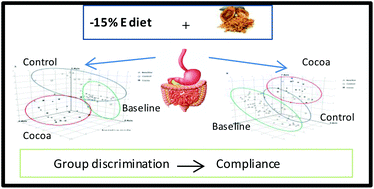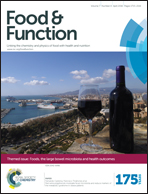The urinary metabolomic profile following the intake of meals supplemented with a cocoa extract in middle-aged obese subjects†
Abstract
Metabolomics is used to assess the compliance and bioavailability of food components, as well as to evaluate the metabolic changes associated with food consumption. This study aimed to analyze the effect of consuming ready-to-eat meals containing a cocoa extract, within an energy restricted diet on urinary metabolomic changes. Fifty middle-aged volunteers [30.6 (2.3) kg m−2] participated in a 4-week randomised, parallel and double-blind study. Half consumed meals supplemented with 1.4 g of cocoa extract (645 mg polyphenols) while the remaining subjects received meals without cocoa supplementation. Ready-to-eat meals were included within a 15% energy restricted diet. Urine samples (24 h) were collected at baseline and after 4 weeks and were analyzed by high-performance-liquid chromatography-time-of-flight-mass-spectrometry (HPLC-TOF-MS) in negative and positive ionization modes followed by multivariate analysis. The relationship between urinary metabolites was evaluated by the Spearman correlation test. Interestingly, the principal component analysis discriminated among the baseline group, control group at the endpoint and cocoa group at the endpoint (p < 0.01), although in the positive ionization mode the baseline and control groups were not well distinguished. Metabolites were related to theobromine metabolism (3-methylxanthine and 3-methyluric acid), food processing (L-beta-aspartyl-L-phenylalanine), flavonoids (2,5,7,3′,4′-pentahydroxyflavanone-5-O-glucoside and 7,4′-dimethoxy-6-C-methylflavanone), catecholamine (3-methoxy-4-hydroxyphenylglycol-sulphate) and endogenous metabolism (uridine monophosphate). These metabolites were present in higher (p < 0.001) amounts in the cocoa group. 3-Methylxanthine and L-beta-aspartyl-L-phenylalanine were confirmed with standards. Interestingly, 3-methoxy-4-hydroxyphenylglycol-sulphate was positively correlated with 3-methylxanthine (rho = 0.552; p < 0.001) and 7,4′-dimethoxy-6-C-methylflavanone (rho = 447; p = 0.002). In conclusion, the metabolomic approach supported the compliance of the volunteers with the intervention and suggested the bioavailability of cocoa compounds within the meals.


 Please wait while we load your content...
Please wait while we load your content...